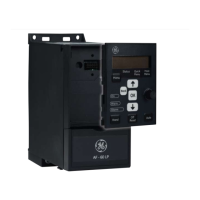[7] Run in Range/No Warn-
ing
Motor runs within programmed current ranges, see parameters 4-50 and 4-51. No warnings are present.
[8] Run on ref/No Warning Motor runs at reference speed.
[9] Alarm An alarm activates output.
[10] Alarm on Warning An alarm or warning activates output.
[12] Out of Current Range Motor current is outside range set in parameters 4-50 and 4-51.
[13] Below Current, low Motor current is lower than set in par. 4-50.
[14] Above Current, high Motor current is higher than set in par. 4-51.
[21] Thermal Warning Thermal warning is present when temperature exceeds limit in motor, frequency converter, brake resistor or thermistor.
[22] Ready, No Thermal
Warning
Frequency converter is ready for operation and no over-temperature warning is present.
[23] Remote Ready, No Ther-
mal Warning
Frequency converter is ready for operation in Auto mode, and no over-temperature warning is present.
[24] Ready, Voltage OK Frequency converter is ready for operation and mains voltage is within specified voltage range.
[25] Reverse Motor runs/is ready to run clockwise when logic = 0 and counter clockwise when logic = 1. Output changes as soon
as reversing signal is applied.
[26] Bus OK Active communication (no time-out) via serial communication port.
[28] Brake, No Warn Brake is active, and no warnings are present.
[29] Brake Ready/No Fault Brake is ready for operation, and no faults are present.
[30] Brake Fault (IGBT) Protects frequency converter if fault on brake modules is present. Use relay to cut out main voltage from frequency
converter.
[32] Mech. Brake Control Enables control of external mechanical brake, see parameter group 2-2*.
[36] Control Word Bit 11 Bit 11 in control word controls relay.
[51] Local Ref Active
[52] Remote Ref Active
[53] No Alarm
[54] Start Cmd Active
[55] Running Reverse
[56] Drive in Hand Mode
[57] Drive in Auto Mode
[60] Comparator 0 See par. group 13-1*. If comparator 0 is evaluated as TRUE, output goes high. Otherwise, it is low.
[61] Comparator 1 See par. group 13-1*. If comparator 1 is evaluated as TRUE, output goes high. Otherwise, it is low.
[62] Comparator 2 See par. group 13-1*. If comparator 2 is evaluated as TRUE, output goes high. Otherwise, it is low.
[63] Comparator 3 See par. group 13-1*. If comparator 3 is evaluated as TRUE, output goes high. Otherwise, it is low.
[70] Logic Rule 0 See par. 13-4*. If Logic Rule 1 is evaluated as TRUE, output goes high. Otherwise, it is low.
[71] Logic Rule 1 See par. 13-4*. If Logic Rule 2 is evaluated as TRUE, output goes high. Otherwise, it is low.
[72] Logic Rule 2 See par. 13-4*. If Logic Rule 3 is evaluated as TRUE, output goes high. Otherwise, it is low.
[73] Logic Rule 3 See par. 13-4*. If Logic Rule 3 is evaluated as TRUE, output goes high. Otherwise, it is low.
[81] Logic Controller Digital
Output B
See par. 13-52 SL Control Action. When Logic Controller Action Set dig. out. A high [39] is executed, input goes high.
When Smart Logic Action Set dig. out. A low [33] is executed, input goes low.
5-40 Function Relay
Option: Function:
[0]
*
No Operation Select function from available relay output range.
4.6.4. 5-5* Pulse Input
Set par. 5-15 to choice [32] pulse input. Now terminal 33 handles a pulse input in the range from Low frequency, par. 5-55, to High frequency, par. 5-56. Scale
frequency input via par. 5-57 and par. 5-58.
AF-60 LP™ Micro Drive Programming Guide
34
4

